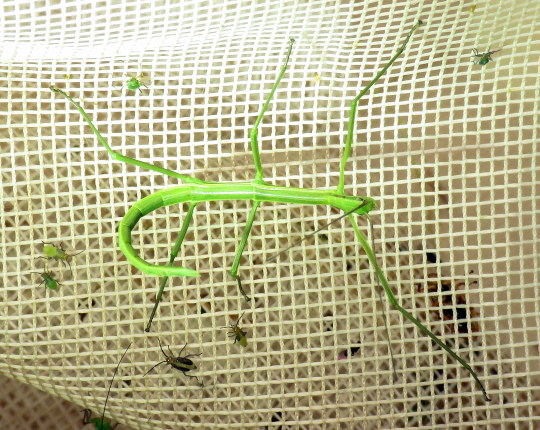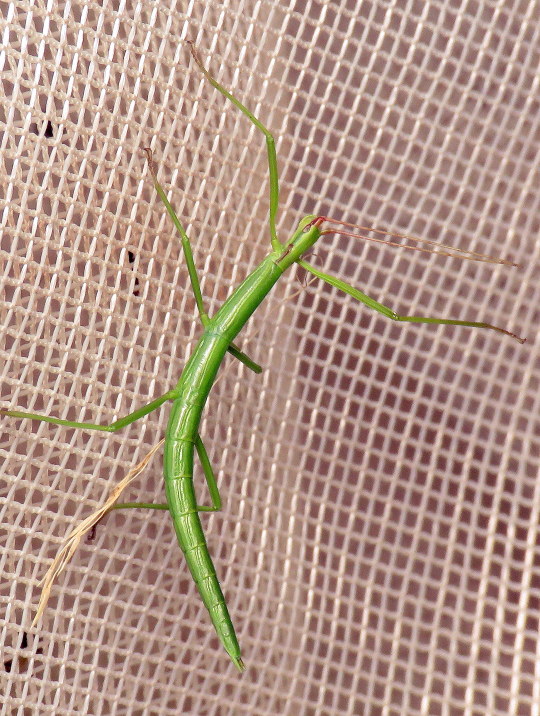#Diapheromeridae
Text

Giant Walking Stick (Megaphasma denticrus), female, family Diapheromeridae, Government Canyon, South-central TX, USA
This species grow up to 7 inches in length.
photograph by Texas Parks and Wildlife
#phasmatodea#walking stick#stick insect#megaphasma#diapheromeridae#insect#entomology#animals#nature#north america
229 notes
·
View notes
Text



Bug of the Day
We interrupt your regularly scheduled programming for...
BABY
STICK
INSECTS!!!!!!!!!!
Omg, how cute are these things? My sweep nets were full of them the other night. Pretty sure they are Blatchley walkingsticks, Manomera blatchleyi.
#Blatchley walkingstick#walkingstick#stick insects#insect#insects#Manomera blatchleyi#Manomera#Diapheromeridae#phasmida#phasmid#phasmids#baby stick insects!!!#BotD#bug of the day
261 notes
·
View notes
Text


my stick bug eggs that i bought at a reptile expo back in april have started hatching 🥺
#only 1 hatched so far.. out of 15 eggs#hes so cute!!#stick bug#northern walkingstick#Diapheromeridae#entomology#bugblr
188 notes
·
View notes
Video
Moss Mimic Stick Insect, Trychopeplus thaumasius? by Andreas Kay
Via Flickr:
from Finca Palmonte, Baños, Ecuador: fincapalmonte.com/welcome.html www.youtube.com/AndreasKay
#Andreas Kay#Diapheromeridae#Ecuador#Finca Palmonte#focus stack#moss mimic stick insect#Phasmatodea#phasmid#Phasmida#Trychopeplus thaumasius?#walking stick
14 notes
·
View notes
Video
Moss mimic Stick Insects, Trychopeplus thaumasius? by Andreas Kay
Via Flickr:
watch my VIDEO: youtu.be/vZPVeJhld_I from Finca Palmonte, Baños, Ecuador: fincapalmonte.com/welcome.html
#Andreas Kay#Diapheromeridae#Ecuador#Finca Palmonte#moss mimic stick insect#Phasmatodea#phasmid#Phasmida#Trychopeplus thaumasius?#walking stick
69 notes
·
View notes
Photo



THROWBACK THURSDAY
Northern walking stick (Diapheromera femorata), Welder Wildlife Refuge, Sinton TX. July 2013.
This walking stick is more at home in trees and forests than my previous entry, as they resemble a branching twig at rest (and a poor form of camouflage against a stone wall). Northern walking sticks spend most of their time feeding in the canopies of trees, and have been reported to feed on cherry, locust, hazelnut, and oak (this one was found under live oak, Quercus virginiana).
After mating, eggs are simply dropped by females from the canopy. These eggs may reside in the leaf litter up to a year’s time before hatching, at which point the immatures (nymphs) clamber up the tree and begin feeding. Because these walking sticks are wingless, their populations tend to be very localized, and under fair years, large numbers of walking sticks may defoliate trees.
1 note
·
View note
Photo








Peruvian fern insect, Oreophoetes peruana, Diapheromeridae, Phasmida
Photos 1-2 by sindic, 3 by geneise, 4 by grahamwise, 5 by Kjeld S, 6-7 by brianlee, and 8 by michaelbakkerpaiva
#animals#curators on tumblr#insects#bugs#stick insect#stick bug#walking stick#peruvian fern insect#phasmid#one nice bug
669 notes
·
View notes
Photo

This is the 149th installment of ‘Since I’ve Been Gone’. Taken on the same day as the previous post during my time with @americanconservationexperience, my crewmate had found a northern walkingstick (Diapheromera femorata). I believe this one was a female. It’s not often that you see one given they prefer to feed in the canopies of deciduous trees. I wish I could find my crewmate’s Instagram account.
#animal #animals #wildlife #texaswildlife #nature #fauna #imago #texasnature #insect #insectagram #insects #phasmid #phasmids #walkingsticks #walkingstick #animalia #arthropod #arthropods #arthropoda #insecta #phasmatodea #diapheromeridae #diapheromera #diapheromerafemorata #northernwalkingstick #commonwalkingstick (at Port Aransas, Texas)
https://www.instagram.com/p/CXWZoDXqqA1/?utm_medium=tumblr
#animal#animals#wildlife#texaswildlife#nature#fauna#imago#texasnature#insect#insectagram#insects#phasmid#phasmids#walkingsticks#walkingstick#animalia#arthropod#arthropods#arthropoda#insecta#phasmatodea#diapheromeridae#diapheromera#diapheromerafemorata#northernwalkingstick#commonwalkingstick
2 notes
·
View notes
Text
Ridleys stick insect.
Status-extinct

Pseudobactricia Ridley, also known as Ridleys stick insect is an extinct stick insect of the family Diapheromeridae. The species was endemic to Singapore. Only scientifically discovered in 1904 abs last officially recorded between 1904-1907. Habitat loss and possibly the traditional medicine trade is believed to have driven this species to extinction.

0 notes
Photo

🦗Marmessoidea rosea🦗 El insecto palo rosa alado ( Sipyloidea sipylus ), también llamado insecto palo de Madagascar , es una especie de fásmido o insecto palo del género Sipyloidea de la familia Diapheromeridae. Es el fásmido más extendido del mundo, se puede encontrar en toda Asia tropical y partes del sudeste asiático. . . . #insectos #insect #insectopalo #butterfly #watercolour #insectwatercolor #butterflywatercolor #wildlifeonearth #wildlife #wildlifewatercolor #mariposario #retomariposario #retobertallonch https://www.instagram.com/p/B-2ymz5DTEK/?igshid=wlo9bkzz00iw
#insectos#insect#insectopalo#butterfly#watercolour#insectwatercolor#butterflywatercolor#wildlifeonearth#wildlife#wildlifewatercolor#mariposario#retomariposario#retobertallonch
0 notes
Photo




7/26/17 Walking Stick.
Kingdom Animalia (Animals)
Phylum Arthropoda (Arthropods)
Subphylum Hexapoda (Hexapods)
Class Insecta (Insects)
Order Phasmida (Walkingsticks)
Family Diapheromeridae
Synonyms and other taxonomic changes
according to recent studies (Bradler 2009), this group is polyphyletic, so taxonomic changes are to be expected
Numbers
by far the largest family in our area, with 19 spp. in 6 genera(1) and ca. 130 genera worldwide(2)
Range
tropical and warm temperate areas worldwide(2)
#walking stick#insects#insect photography#macro photography#nature photography#Kentucky insects#entomology#source BugGuide#photographers on tumblr
73 notes
·
View notes
Text


Peruvian Firestick aka Peruvian Fern Stick Insect (Oreophoetes peruana), family Diapheromeridae, found in alpine forests of Peru and Ecuador
Feed on various species of fern.
Females are larger and striped, males are red.
photographs by Roberto Sindaco & Dragus
#stick insect#oreophoetes#diapheromeridae#phasmatodea#insect#entomology#south america#animals#nature
291 notes
·
View notes
Video
undefined
tumblr
Bug of the Day
I was on the wrong side of the door tonight :-(
(Northern Walkingstick, Diapheromera femorata)
#walkingstick#Northern walkingstick#Diapheromera femorata#Diapheromera#Diapheromeridae#Phasmida#Phasmid#insect
243 notes
·
View notes
Photo

オンコトファズマ・マルティニ
(ナナフシ目: Diapheromeridae: Diapheromerinae)の卵
Eggs of a stick insect, Oncotophasma martini
ナナフシのメスを飼育している袋の中に、糞と一緒に卵がまぎれていた。思わず糞ごと捨ててしまうところだった。この卵の茶色い殻は、キュッと強くつまむとつぶれてしまうくらいの硬さ。先についているオレンジっぽい突起は、卵の蓋の一部だ。
長さ:3 mm 撮影地:サン・ラモン、コスタリカ(写真クリックで拡大)
http://natgeo.nikkeibp.co.jp/nng/article/20120910/322537/
0 notes
Video
Moss mimic Stick Insects, Trychopeplus thaumasius? by Andreas Kay
Via Flickr:
watch my VIDEO: youtu.be/xCqqnu2Xk2M from Finca Palmonte, Baños, Ecuador: fincapalmonte.com/welcome.html
#Diapheromeridae#Finca Palmonte#moss mimic stick insect#Phasmatodea#phasmid#Phasmida#Trychopeplus thaumasius?#walking stick
59 notes
·
View notes
Photo

THROWBACK THURSDAY
Prairie walking stick (Diapheromera velii), Welder Wildlife Refuge, Sinton TX. July 2013.
The prairie walking stick is nocturnal, venturing out in the night to feed on grasses and mate. During the day, they cling to grass stems and remain motionless, attempting to blend into the background of a grassland. This is especially true in Texas prairies where little rain in the summer turns the grass the same color as the insect. If the insect is spotted by predators, however, the walking stick can provide a second mechanism for defense: by releasing droplets of foul-tasting (and smelling) liquid from their legs.
Although they prefer big bluestem (Andropogon gerardii), this insect was found on Old World bluestem (Dichanthium annulatum), a grass closely related to Andropogon, but also an invasive that has been replacing native grasses. I did not observe other walking sticks during the three years of my research on Old World bluestems, so I do not think these walking sticks benefit from the invasive grass.
1 note
·
View note
